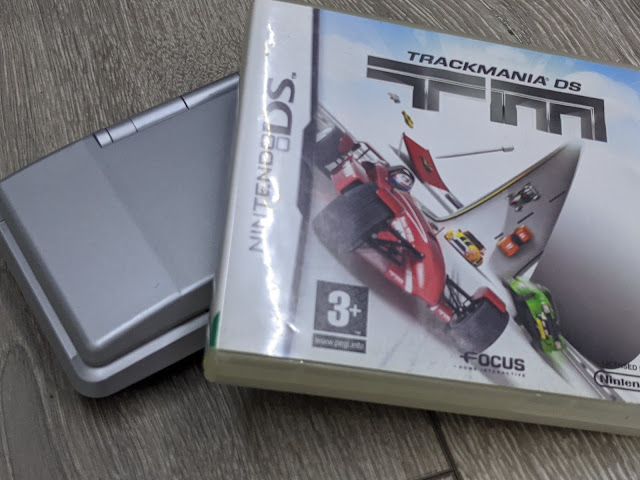As I was hitting the instant reset button on Trackmania DS for about the 457th time in my first 10 minutes, two things struck me...
At some point, fairly recently in the history of video games, it became the norm to suggest that ‘trial and error’ was a mechanic flawed by definition. I’d have to imagine this was towards the beginning of the 7th console generation, as it was at this time that frustrated film makers started to ply their trade in video games, and the very idea of ‘failure’ became very unfashionable.
Trial and error is the same as any gameplay element; it can be clever, fun, and addictive - or it can be boring, frustrating, and cheap.
This was ‘Point A’: The idea that trial and error is a poor mechanic by definition is bunk.
The other thing is related to this. As the mainstream courted audiences outside the core gamer demographic by offering (barely) “Interactive Experiences”, the indie scene reacted in the best way it knows how: By making games that revelled in failure, embraced trial and error, and excelled because of it.
Trackmania wasn’t born from this era, but it was at this time that it started to be noticed away from it’s cult following on PC, and I put that down to a growing appetite for this kind of thing thanks to the success of other games.
And this is ‘Point B’: The best way to describe Trackmania to someone who hasn’t played it: ‘Super Meat Boy Kart’.
Which, now I’ve said it, is a mental image that Trackmania couldn’t possibly live up to… Oh well, no take-sies back-sies.
The reason for this epic sounding, but potentially misleading, portmanteau is the common, frantic, gameplay loop of try-fail-try-fail-try-fail-try-succeed-”but I think I can do better”-try-fail. ‘Super Meat Boy’ and ‘Trackmania DS’ (and many others, of course) both offer a gameplay experience that is born of pure arrogance. These games know that they are so fun to play, and that success in them is so tantalising, that you will keep coming back for more no matter how many times you fail to complete a single short level.
For Trackmania DS’s core ‘Race’ levels this is very much the name of the game.
There are 75 levels (of which I’ve played about half at this time) that vary in length and style across three types; Stadium, Desert, and Rally.
PC entries in this series feature many more environments, but these three represent a remarkably diverse feature-set, front and centre of which is the different vehicle used for each.
The F1 style car for the ‘Stadium’ tracks is fast and sticks to the road. The Renault 5 inspired ‘Rally’ car is incredibly twitchy and accelerates like a bullet, and the sedan used in the ‘Desert’ tracks occupies the middle ground between the two.
In many ways wrestling these vehicles around the tracks feels like ‘Micro Machines’ or ‘Toy Commander’; the physics are deliberately light and the resultant feel is one of barely restrained chaos. All the courses are ‘open’ and, as much as this helps when you want to cut a corner, it can equally hinder when you take a jump too fast and land in a field.
But, as I’ve said already, in Trackmania DS failure is all part of the fun. Piecing together the perfect run through a level can be the sum of dozens of failed attempts, and facilitating this is the simple but incredibly powerful ‘instant’ restart button - a feature I would love to see in just about every game ever made. The complete absence of confirmation questions, loading screens, or other options between the player’s latest failure and them appearing again at the (literal or figurative) starting line.
In ‘Race’ mode there are three ghost cars to beat, and while this essentially means that each level is a time trial, the visual representations are a godsend when learning the course.
Other racers would have been similarly illustrated in online multiplayer, were that not a disappointing omission at the time of release - although if it had been included it would have been, ironically, a ghost town today.
It’s testament, both to the amount of content in Trackmania DS and the addictiveness of the core ‘Race’ experience, is that I’ve barely touched the other, non-race, modes.
‘Platform’ gives you unlimited time,but adds challenge by insisting you complete each of it’s fiendishly designed courses with no restarts. These tracks are vast and devious; deliberately throwing you through gaps in the course, and tempting you to go faster, and then planting a wall in your face. If you like swearing at developers who can’t hear you, this is the mode you want.
‘Puzzle’ is the final mode and the one I’ve played least. It uses the game’s in depth course creator (which I haven’t tried at all yet) to set up levels that you have to add elements to in order to complete.
The lack of multiplayer, regardless of the reason, is a sad loss for a game which thrives in this environment on other platforms and, although I didn’t encounter any, there are enough reports of clipping and glitches for it to be a genuine concern, but as a single player arcade racer Trackmania, with it’s bite-sized levels, is a great fit for the handheld format of DS.

No comments:
Post a Comment